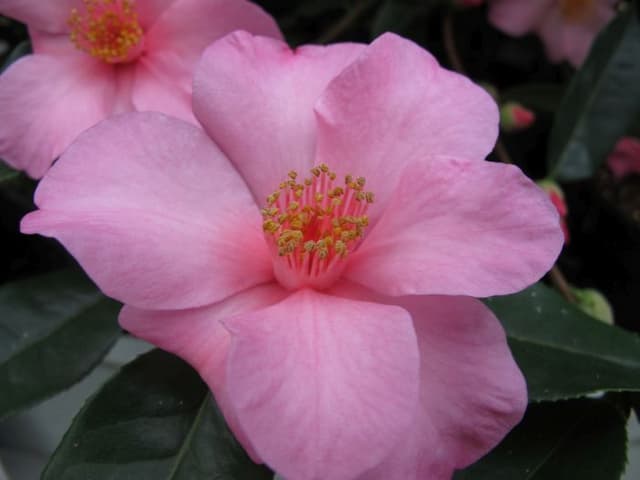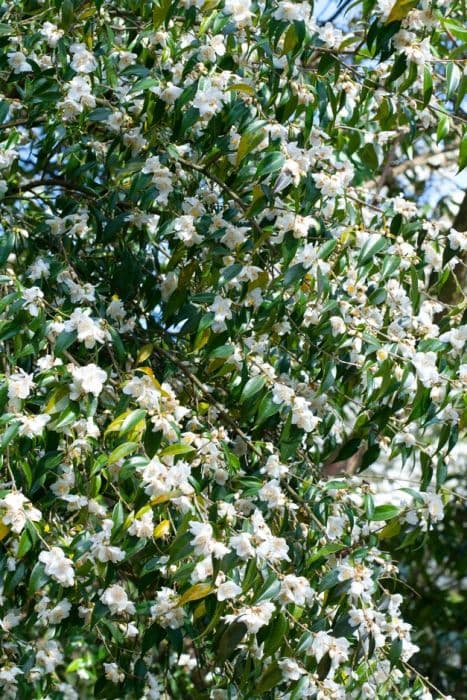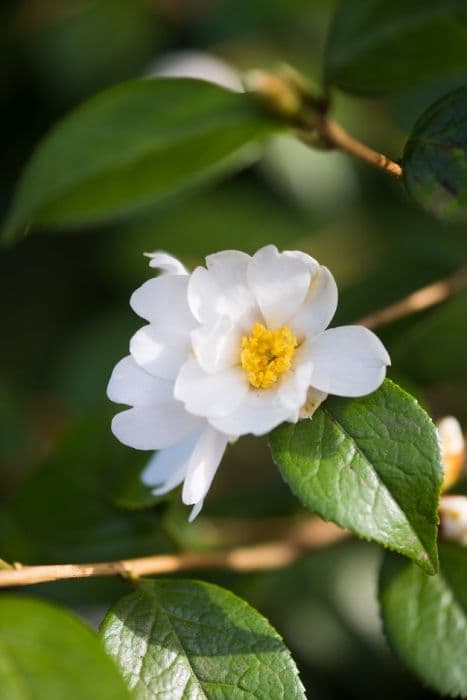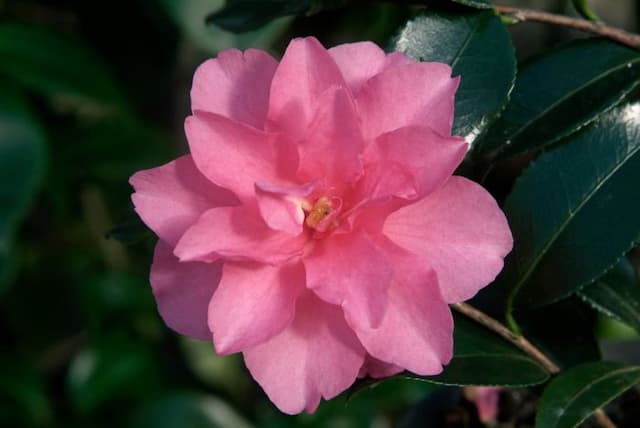Camellia Camellia 'Show Girl' (reticulata × sasanqua)

ABOUT
The Camellia 'Show Girl' is a strikingly beautiful ornamental plant known for its large, showy flowers that can capture the attention of any plant enthusiast. The blooms exhibit a vibrant and glossy appearance, with petals typically exhibiting shades of deep pink that can sometimes fade to a softer pink or nearly white at the edges. These petals are arranged in a loose peony form, offering a lush and ruffled look that adds to the overall elegance of the flower. Flowering from late winter to early spring, the Camellia 'Show Girl' provides a burst of color during a time when many plants are still dormant. The lustrous, evergreen leaves present a dark green hue and serve as a perfect backdrop to the extravagant flowers. The foliage is leathery in texture with a slightly serrated edge, and it remains attractive throughout the year, adding to the plant's ornamental value. Overall, the Camellia 'Show Girl' presents a luxurious presence in any garden, with its sumptuous flowers and rich, green foliage creating a splendid display that's hard to miss. Its elegant appearance makes it a choice plant for gardeners looking to add a touch of sophistication to their landscapes.
About this plant
 Names
NamesFamily
Theaceae.
Synonyms
Show Girl Camellia, Showgirl Camellia.
Common names
Camellia 'Show Girl' (reticulata × sasanqua)
 Toxicity
ToxicityTo humans
Camellias, including the hybrid Camellia 'Show Girl', are generally not considered toxic to humans. There is no significant evidence to suggest that ingestion of parts of this plant leads to poisoning or adverse health effects in humans.
To pets
Camellias, such as the Camellia 'Show Girl' hybrid, are also typically non-toxic to pets. If a pet ingests parts of this plant, it is unlikely to cause poisoning. However, ingestion of any plant material may cause mild gastrointestinal upset in some pets, such as vomiting or diarrhea, due to the plant matter itself rather than specific toxins.
 Characteristics
CharacteristicsLife cycle
Perennials
Foliage type
Evergreen
Color of leaves
Green
Flower color
Pink
Height
6-12 feet (1.8-3.7 meters)
Spread
5-10 feet (1.5-3 meters)
Plant type
Shrub
Hardiness zones
7-9
Native area
East Asia
Benefits
 General Benefits
General Benefits- Aesthetic Appeal: Camellia Show Girl offers a visually stunning display with its large, showy flowers that can enhance the beauty of gardens and landscapes.
- Long Blooming Period: It typically has a long blooming season from winter to early spring, providing color when many other plants are dormant.
- Versatility: This camellia can be used in various garden settings, including borders, foundation plantings, and as a specimen plant.
- Evergreen Foliage: The plant maintains its glossy, dark green leaves throughout the year, providing continuous foliage interest.
- Drought Tolerance: Once established, Camellia Show Girl exhibits some drought resistance, making it more adaptable to different climates.
- Shade Tolerance: It can thrive in partial shade, making it suitable for shaded gardens where many other flowering plants might struggle.
- Soft Screening: Camellia Show Girl can be used for creating informal hedges or privacy screens due to its dense growth habit.
- Wildlife Attraction: The flowers can attract pollinators, such as bees, adding to the biodiversity of the garden environment.
 Medical Properties
Medical PropertiesThis plant is not used for medical purposes.
 Air-purifying Qualities
Air-purifying QualitiesThis plant is not specifically known for air purifying qualities.
 Other Uses
Other Uses- Camellia 'Show Girl' can be used for artistic inspiration due to its vibrant and intricate flowers that often inspire painters and illustrators in their work.
- The large petals of the Camellia can be used for crafting, such as creating natural potpourri or decorative table spreads for festive occasions.
- These plants can be grown as privacy screens in gardens, given their dense foliage and potential to grow at moderate height.
- Fallen Camellia petals can be collected and used for creating natural dyes for fabric and paper, resulting in unique shades of pink and red.
- Camellia blossoms can be floated in bowls of water to create simple, elegant aquatic displays for events or home decor.
- The sturdy branches of Camellia 'Show Girl' might be used in the construction of small garden structures like trellises or plant supports.
- Dried Camellia flowers can be incorporated into homemade candles to add a floral touch and texture to the wax as they burn.
- The glossy leaves of the Camellia can be used in floral arrangements to add rich green contrast to colorful blooms.
- Camellia wood, while not commonly used, can be crafted into small woodworking projects such as decorative boxes or inlay work.
- The Camellia 'Show Girl' variety specifically, with its unique flower structure, can serve as a living science lesson for botany students studying hybridization and flower anatomy.
Interesting Facts
 Feng Shui
Feng ShuiThe Camellia is not used in Feng Shui practice.
 Zodiac Sign Compitability
Zodiac Sign CompitabilityThe Camellia is not used in astrology practice.
 Plant Symbolism
Plant Symbolism- Admiration: The Camellia 'Show Girl', commonly known as Camellia, symbolizes deep admiration for the beauty and perfection of the recipient.
- Perfection: Often considered the ideal of perfected beauty, the Camellia represents the pursuit of excellence and flawless charm.
- Love: With its elegant form and association with the heart, Camellias are often given to express romantic love.
- Longevity: The sturdy nature and long blooming season of the Camellia stand for the enduring and sustained nature of life.
- Gratitude: In certain cultures, giving a Camellia is a way to show gratitude or appreciation towards someone.
- Refinement: The sophistication of Camellias makes them a symbol for refined beauty and civilized behavior.
 Water
WaterThe Show Girl Camellia should be watered thoroughly to ensure even soil moisture, ideal for its growth. During its growing season in spring and summer, water the plant once a week with about 1–1.5 gallons, focusing on the base and avoiding wetting the foliage, which can lead to fungal diseases. In the fall and winter, reduce watering to every two to three weeks, monitoring the soil moisture level to prevent it from drying out entirely. Always check the top inch of soil; if it feels dry, it's time to water.
 Light
LightShow Girl Camellias thrive in partial shade, protected from intense afternoon sun which can scorch their leaves. The best spot for them is where they can receive filtered morning sunlight and dappled shade during the hottest part of the day. They can also do well in full shade, especially in hotter climates, but may produce fewer flowers.
 Temperature
TemperatureShow Girl Camellias prefer moderate temperatures and can endure a temperature range from 20°F to 90°F. However, the optimal temperatures for them are between 60°F and 70°F. They are sensitive to extreme cold and hot temperatures, so it's crucial to plant them in a location that avoids frost and the intense heat of summer afternoons.
 Pruning
PruningPrune Show Girl Camellias to maintain their shape and remove any dead or weak branches to promote good air circulation. The best time for pruning is after they have finished blooming in the spring. Light pruning can be done annually, but remember that heavy pruning may reduce flowering for the next season.
 Cleaning
CleaningAs needed
 Soil
SoilCamellias prefer well-draining, acidic soil with a pH between 5.5 and 6.5. A best soil mix for Camellias like 'Show Girl' can be made of 1 part peat, 1 part pine bark fines, and 1 part perlite or coarse sand. This combination ensures proper drainage and aeration while retaining adequate moisture.
 Repotting
RepottingCamellias, including 'Show Girl,' typically need repotting every 2-3 years. It's best to repot in the spring before the growing season begins. Choose a pot that's only slightly larger than the previous one to avoid excess soil moisture, which can lead to root rot.
 Humidity & Misting
Humidity & MistingCamellias like 'Show Girl' thrive in moderate to high humidity levels, ideally between 40% to 60%. They benefit from a humid environment but also require good air circulation to prevent fungal diseases.
 Suitable locations
Suitable locationsIndoor
Place Camellias near a window with bright, indirect light and away from heat sources.
 Life cycle
Life cycleThe Camellia 'Show Girl', commonly known as the hybrid camellia, begins its life cycle as a seed, which after undergoing stratification germinates in moist, well-drained soil. As a seedling, it slowly establishes a root system and develops true leaves, adapting to its environment. Upon reaching maturity, the hybrid camellia becomes a bushy shrub, often requiring several years to bloom, during which it develops woody stems and glossy, evergreen leaves. Flowering typically occurs in late winter to early spring, showcasing large, ornate blossoms that range from white to various shades of pink and red. After pollination, the flowers develop into seed capsules, dispersing seeds to propagate the next generation. This perennial plant then enters a period of dormancy, particularly in colder climates, until the next growing season.
 Propogation
PropogationPropogation time
Winter-Spring
The Camellia 'Show Girl', a cross between Camellia reticulata and Camellia sasanqua, is most commonly propagated through taking semi-hardwood cuttings, which is done typically during late summer or early fall. To propagate, select a healthy, non-flowering stem and cut a 4 to 6-inch (about 10 to 15 centimeters) portion, making sure it includes at least two or three sets of leaves. Dip the cut end into a rooting hormone powder to stimulate root growth, then place the cutting into a pot filled with a mixture of peat and perlite or coarse sand to ensure good drainage. The pot should then be covered with a plastic bag to maintain a humid environment and placed in indirect light. Roots generally develop in a few months, after which the cutting can be transplanted into a larger pot or the garden.









